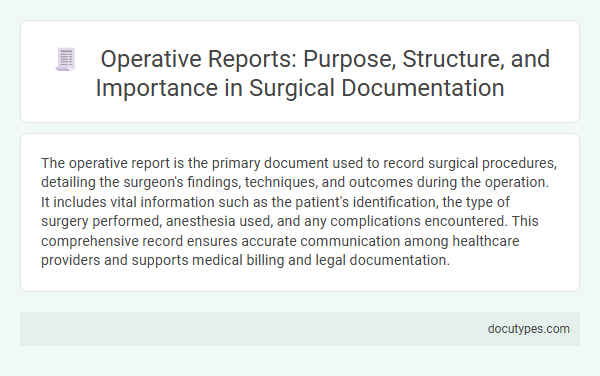The operative report is the primary document used to record surgical procedures, detailing the surgeon's findings, techniques, and outcomes during the operation. It includes vital information such as the patient's identification, the type of surgery performed, anesthesia used, and any complications encountered. This comprehensive record ensures accurate communication among healthcare providers and supports medical billing and legal documentation.
Introduction to Operative Reports in Medical Documentation
| Topic | Description |
|---|---|
| Document for Recording Surgical Procedures | Operative Report |
| Definition | An Operative Report is a formal medical document detailing the specifics of a surgical procedure performed by the surgeon. |
| Purpose | To provide a comprehensive account of the surgery, including preoperative diagnosis, surgical techniques used, findings, and postoperative instructions. |
| Components of an Operative Report |
|
| Importance in Medical Documentation | Operative Reports serve as essential medical records for legal documentation, continuity of care, insurance claims, quality assurance, and medical research. |
| Standardization | Hospitals and healthcare providers often follow standardized templates or electronic medical record systems to ensure accuracy, completeness, and compliance with regulations. |
| Summary | The Operative Report is the authoritative document used to record surgical procedures. It provides detailed medical documentation crucial to postoperative management and medical-legal protocols. |
Defining the Purpose of Operative Reports
An operative report is the primary document used to record surgical procedures. It provides a detailed account of the surgery, including the techniques used, findings, and patient status. The purpose of the operative report is to ensure accurate communication between surgical teams, facilitate postoperative care, and serve as a legal record.
Key Components and Structure of Operative Reports
The primary document used to record surgical procedures is the operative report. This report provides a detailed account of the surgery performed, ensuring accurate medical records and continuity of care.
Key components of an operative report include patient identification, date and time of surgery, and the names of the surgical team. The structure typically follows a format covering preoperative diagnosis, surgical procedure, anesthesia used, findings, and postoperative condition.
Preoperative Information and Patient Consent
What document is used to record surgical procedures, including preoperative information and patient consent? The surgical consent form is essential for documenting patient authorization and detailed preoperative data. This form ensures legal compliance and facilitates clear communication between the surgical team and the patient.
Intraoperative Details and Surgical Findings
The document used to record surgical procedures is the Operative Report. It captures detailed intraoperative details and surgical findings essential for patient care documentation.
- Operative Report - A comprehensive record of the surgical procedure, including technique, instruments used, and steps taken.
- Intraoperative Details - Includes vital information such as anesthesia type, patient positioning, and timing during surgery.
- Surgical Findings - Documents observations made during surgery, such as tissue condition, pathology, and any unexpected complications.
This document supports postoperative care, legal records, and interdisciplinary communication in healthcare.
Postoperative Documentation and Recommendations
Postoperative documentation is essential for recording detailed information following a surgical procedure, ensuring patient safety and continuity of care. This document includes vital data on surgical outcomes, complications, and specific postoperative instructions.
- Surgical Operative Report - The primary document used to record the specifics of the surgical procedure performed, including findings and techniques.
- Postoperative Note - A detailed record written immediately after surgery outlining the patient's condition, pain management, and recovery status.
- Discharge Summary - Provides comprehensive recommendations and instructions for patient care after leaving the hospital, including follow-up plans and medication guidelines.
Legal and Regulatory Requirements for Operative Reports
The operative report is the primary document used to record surgical procedures, detailing the specifics of the surgery performed. This document is essential for legal accountability, patient care continuity, and compliance with healthcare regulations.
- Legal Documentation - The operative report serves as a legal record that verifies the procedures conducted, protecting both the patient and healthcare provider in case of disputes.
- Regulatory Compliance - Healthcare institutions must maintain accurate and complete operative reports to comply with regulatory agencies such as the Joint Commission and CMS standards.
- Patient Care Continuity - Detailed operative reports ensure that postoperative care teams have critical information to guide recovery and future medical decisions.
The Role of Operative Reports in Patient Safety and Care Continuity
The document used to record surgical procedures is called an operative report. This report provides a detailed account of the surgery performed, including the technique, findings, and any complications encountered.
Operative reports are crucial for patient safety as they ensure accurate communication among healthcare providers. They support care continuity by serving as a reference for postoperative management and future medical interventions.
Common Challenges in Operative Report Documentation
The operative report is the primary document used to record surgical procedures. It provides a detailed account of the surgery, including the techniques, findings, and patient condition during the operation.
Common challenges in operative report documentation include incomplete or vague descriptions of the surgical steps, which can hinder postoperative care and legal review. Inconsistent terminology and lack of standardization often lead to confusion among healthcare providers. Accurate and thorough documentation is essential to ensure patient safety and facilitate communication within the medical team.
What Document Is Used to Record Surgical Procedures? Infographic

